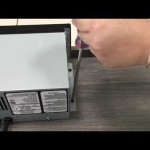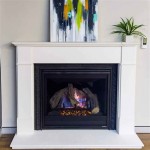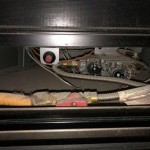Add-On Fireplace Mantel: Enhancing Aesthetics and Functionality
An add-on fireplace mantel provides a versatile and cost-effective way to enhance the visual appeal and functionality of an existing fireplace. Unlike a complete fireplace replacement, which involves substantial demolition and reconstruction, an add-on mantel is designed to be installed over or around an existing fireplace surround. This approach offers a range of benefits, from updating the style of the fireplace to providing additional storage or display space. This article will explore the various aspects of add-on fireplace mantels, including their types, materials, installation considerations, and design possibilities.
Fireplaces are often focal points of a room, and their aesthetic impact can significantly influence the overall ambiance of the space. An outdated or unappealing fireplace can detract from the room's decor. Opting for an add-on mantel provides an opportunity to modernize the fireplace without the complexity and expense of a full renovation. These mantels are available in a diverse array of styles, allowing homeowners to match their existing decor or introduce a completely new design element.
Types of Add-On Fireplace Mantels
Add-on fireplace mantels can be categorized based on their design, construction, and installation method. Understanding these different types is crucial for selecting the right mantel for a specific fireplace and design preference.
Surround Mantels: These mantels encompass the entire fireplace opening, creating a frame around the firebox and surround. They are typically made from wood, stone, or composite materials and offer a substantial visual impact. Surround mantels often include legs or pilasters that extend down to the floor, providing a more traditional and formal appearance. They are suitable for fireplaces with plain or unremarkable surrounds, as they completely conceal the existing structure.
Shelf Mantels: A shelf mantel is a horizontal shelf that is mounted above the fireplace opening. It is a simpler and more minimalist option compared to a surround mantel. Shelf mantels are typically made from wood, but can also be found in stone or metal. They provide a surface for displaying decorative items, such as photos, vases, or artwork. Shelf mantels can be installed on a variety of fireplace surrounds, adding a touch of elegance and functionality.
Floating Mantels: Similar to shelf mantels, floating mantels are horizontal shelves that appear to "float" on the wall above the fireplace. They are typically mounted using hidden brackets or supports, creating a clean and contemporary look. Floating mantels are often preferred in modern and minimalist designs, where the focus is on simplicity and clean lines. They can be constructed from a variety of materials, including wood, concrete, or metal.
Corner Mantels: Designed specifically for fireplaces located in corners, corner mantels are angled to fit the unique shape of the fireplace. They can be either surround mantels or shelf mantels, depending on the desired style and the existing fireplace structure. Corner mantels help to integrate the fireplace into the corner of the room and create a more cohesive design.
Custom Mantels: For those seeking a truly unique and personalized look, custom-made mantels are an excellent option. Custom mantels can be designed to meet specific dimensions, materials, and design preferences. They allow for complete control over the mantel's appearance and can be tailored to complement the existing decor and architectural style of the room. This typically involves working with a carpenter or custom millwork shop.
Materials Used in Add-On Fireplace Mantels
The choice of material for an add-on fireplace mantel is a critical factor influencing its appearance, durability, and cost. Each material possesses unique characteristics that contribute to the overall aesthetic and performance of the mantel.
Wood: Wood is a popular choice for fireplace mantels due to its versatility, warmth, and natural beauty. It can be easily shaped and carved to create intricate designs, and it can be stained or painted to match any decor. Common wood types used for mantels include oak, maple, pine, and cherry. Each wood species has its own grain pattern and color variations, adding to the visual interest of the mantel. Wood mantels can range from rustic to contemporary, depending on the design and finish.
Stone: Stone mantels offer a sophisticated and timeless look. They are durable, fire-resistant, and add a sense of permanence to the fireplace. Common stone types used for mantels include marble, granite, limestone, and slate. Stone mantels are typically more expensive than wood mantels, but their durability and aesthetic appeal make them a worthwhile investment for many homeowners. They often have a heavier presence and feel, lending a sense of grandeur and solidity to the room.
Brick: Brick mantels offer a rustic and traditional look. They are durable, fire-resistant, and can be painted or stained to match any decor. Brick mantels can be constructed from solid brick or brick veneer, depending on the desired thickness and weight. They are often used in homes with a farmhouse or industrial aesthetic.
Metal: Metal mantels offer a sleek and contemporary look. They are durable, fire-resistant, and can be powder-coated or painted in a variety of colors. Common metal types used for mantels include steel, iron, and aluminum. Metal mantels are often used in modern and minimalist designs.
Composite Materials: Composite materials, such as MDF (Medium Density Fiberboard) and resin, are increasingly popular for fireplace mantels. These materials are more affordable than wood or stone and can be molded into intricate designs. They are also resistant to moisture and warping, making them a suitable choice for humid environments. Composite mantels are typically painted or finished with a faux wood or stone veneer.
Installation Considerations for Add-On Fireplace Mantels
Proper installation is essential for ensuring the safety and stability of an add-on fireplace mantel. It is crucial to follow the manufacturer's instructions and adhere to local building codes. Incorrect installation can lead to structural problems or even fire hazards.
Clearance Requirements: Fireplace mantels must meet specific clearance requirements to prevent them from overheating or catching fire. The National Fire Protection Association (NFPA) provides guidelines for safe mantel clearances. Generally, the mantel should be at least 12 inches above the fireplace opening and extend no more than 6 inches out from the wall. These dimensions can vary depending on the type of fireplace and the materials used in the mantel. A qualified professional should be consulted to ensure that the installation meets all applicable safety standards.
Structural Support: The mantel must be securely attached to the wall and capable of supporting its own weight, as well as any decorative items placed on it. Depending on the size and weight of the mantel, it may be necessary to use additional support brackets or anchors. It is important to locate wall studs and use appropriate fasteners to ensure a strong and stable installation. For heavier mantels, professional installation is recommended.
Material Compatibility: The materials used in the mantel and the fireplace surround should be compatible. For example, a wood mantel should not be installed directly against a hot fireplace surround, as this could cause the wood to dry out and crack. It is important to use appropriate insulation or heat shields to protect the mantel from excessive heat.
Leveling and Alignment: The mantel must be installed level and aligned with the fireplace opening. Uneven installation can detract from the visual appeal of the fireplace and may also create structural problems. It is important to use a level and measuring tools to ensure accurate placement.
Professional Installation: While some homeowners may be comfortable installing a simple shelf mantel themselves, more complex installations, such as surround mantels or custom mantels, are best left to a professional. A qualified installer will have the experience and expertise to ensure that the mantel is installed safely and correctly.
In addition to these practical considerations, the addition of a fireplace mantel can significantly elevate the overall design of a room. The right mantel can complement existing furniture and décor and add character to an otherwise plain space. It is a worthwhile investment that can bring years of enjoyment

How To Install A Floating Mantle The Easy Way In Just One Afternoon
:max_bytes(150000):strip_icc()/sandandsisal-bdc76ad938a44d28ae9e23ef6c9fa331.jpg?strip=all)
17 Diy Fireplace Mantel Plans

Custom Built Fireplace Surround Install A New Mantel Hearth

Building An Easy Modern Fireplace Mantel Young House Love

How To Install A Fireplace Mantel

How To Install A Mantel On Brick Fireplace 1905 Farmhouse

Diy Fireplace Mantel And Surround Jenna Kate At Home

Fireplace Mantel Installation Tips How To Antique Woodworks

Easy Fireplace Mantel Diy

Diy Fireplace Mantel Designatedspacedesign Com
Related Posts








